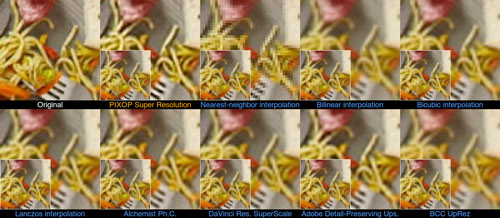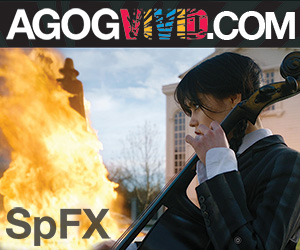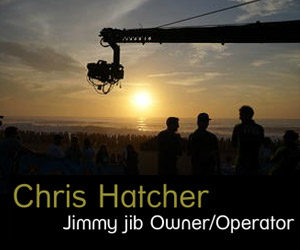Broadcast News
22/11/2019
Comparing Video Upscaling Methods On Stock Footage

At PIXOP we are obsessed with video enhancement and machine learning — our modest ambition is to produce the most appealing digital imagery possible. Prompted by our own curiosity and questions we got while attending the recent IBC2019 show in Amsterdam, we set out to investigate how our current workhorse, PIXOP Super Resolution, fares against other upsampling algorithms — i.e. both classic interpolation methods and commercial software offerings. Well, as you are about to see, our upsampler turned out to be the most accurate in every test.
The Challenge
As no relevant published benchmarks were found, we decided to conduct our own testing. Specifically we measure an algorithm’s ability to reconstruct video in terms of how appealing it is to a human observer via Netflix’s VMAF metric. The ability to hallucinate pixels of the original video accurately is thus determined, i.e. how well challenging features such as edges, textures and curves are preserved and reconstructed. The advantages of this approach are straight-forward objective quantification of performance and reproducibility as opposed to performing visual subjective testing on humans.
Meet the Contestants
We had to limit the scope of our testing and be smart in terms of selecting video footage and competing algorithms. Initially we performed some research and identified the group of candidates to pit against our algorithm. For instance, we have heard the term “industry standard in the broadcast industry” used for both Grass Valley’s Alchemist Ph.C. and Adobe After Effect’s Detail-Preserving Upscale. Both of these were obviously included.
Due to the proprietary nature of many of the algorithms involved it’s impossible to make any predictions about their complexity and sophistication. Each algorithm obviously has its own strengths and weaknesses in areas such as visual quality, speed, ease of use, and flexibility from a UI standpoint. It’s outside the scope of this post to dive deeply into the technical details of each.
Where applicable screenshots of the settings used are included below. Some products offer more flexibility than others. Significant consideration and experimentation was put into aligning the settings as much as possible.
PIXOP — PIXOP Platform (SaaS)
'PIXOP Super Resolution' (internally known as “PABSR1” and part of PIXOP Platform available on www.pixop.com) is our machine learning based algorithm trained on tens of millions of low-res/high-res pairs of image patches. It is able to perform accurate upscaling up to x4 and produces a predictable, robust output which is a distinct advantage over e.g. Deep Learning blackbox methods.
FFmpeg — libswscale (5.3.100)
Four classic linear filtering algorithms are included listed in ascending order of complexity and speed:
• Nearest-neighbor interpolation (point sampling)
• Bilinear interpolation
• Bicubic interpolation
• Lanczos interpolation
None of these algorithms require configuration and have been implemented in many different products over the years. We think highly of the open source video processing tool FFmpeg and for that reason we tested the implementations in “libswscale” that come with FFmpeg 4.2.1.
Grass Valley — Alchemist XF (free trial, 4.0.1.2)
The commercial video file processing tool developed by Grass Valley (formerly Snell). Alchemist is primarily a format and frame-rate conversion tool that also does rescaling by mean of the motion compensation algorithm called “Alchemist Ph.C.” (Ph.C. is short for “Phase Correlation”) which has been around since 1992.
As a side note, Grass Valley also offers Quasar XF which is essentially the same product that only does format conversion and rescaling; no frame-rate conversion.
Blackmagic Design — DaVinci Resolve 16 (free trial, 16.0.0.060)
DaVinci Resolve (Studio) is a native video editor developed by Blackmagic Design. Their proprietary “Super Scale” feature is designed to scale video from SD to HD or even beyond — quoting the new features PDF from DaVinci Resolve 15 they:
… use advanced algorithms to improve the appearance of image detail when enlarging clips by a significant amount, such as when editing SD archival media into a UHD timeline, or when you find it necessary to enlarge a clip past its native resolution in order to create a closeup.
Adobe — After Effects (16.1.13)
Adobe’s After Effects is another commercial video editor. In its more recent incarnations it offers a “Detail-preserving Upscale” which Adobe describes as follows:
The Detail-preserving Upscale effect is capable of scaling up images by large amounts while preserving details in the image. The sharpness of sharp lines and curves is preserved. For example, you can scale up from SD frame sizes to HD frame sizes, or from HD frame sizes to digital cinema frame sizes.
Boris FX — Continuum (free trial, 12.5.2)
The last contestant is Boris FX’s “BCC UpRez” included in their Continuum plugin toolkit. The plugin’s purpose is described as:
BCC Uprez is used to increase the resolution of source clips (for example SD to HD or SD/HD to UHD) while ensuring maximum possible image quality. Uprez uses advanced techniques to maintain and fine tune image details, generating much higher quality final images than can be obtained with standard host upscaling.
Boris FX plugins are available for many different video editors and platforms. We only tested the FCP plugin for Final Cut Pro X 10.4.6.
Test Methodology
All upscalers were tested on three downsampled Shutterstock 1080p HD videos via FFmpeg using the VMAF metric. We strived for a variety of different video types: purely synthetic CG, premium fixed camera position and handheld camera. Using decent quality footage is important to assess simpler algorithms from more sophisticated ones.
VMAF — the quality metric of choice
We decided to use VMAF as the metric for comparing algorithms. VMAF is short for Video Multi-method Assessment Fusion which is a modern video quality metric developed by Netflix that combines human vision modeling with machine learning. It is intended to replace classic scientific metrics like PSNR and SSIM which do not accurately capturing human perception.
Quoting the authors themselves from their Medium announcement post, VMAF scores are interpreted as:
VMAF scores range from 0 to 100, with 0 indicating the lowest quality, and 100 the highest. A good way to think about a VMAF score is to linearly map it to the human opinion scale under which condition the training scores are obtained. As an example, the default model v0.6.1 is trained using scores collected by the Absolute Category Rating (ACR) methodology using a 1080p display with viewing distance of 3H. Viewers voted the video quality on the scale of 'bad', 'poor', 'fair', 'good' and 'excellent', and roughly speaking, 'bad' is mapped to the VMAF scale 20 and 'excellent' to 100. Thus, a VMAF score of 70 can be interpreted as a vote between “good” and “fair” by an average viewer under the 1080p and 3H condition.
A note to the reader here: a viewing distance of 3H means '3 times the height of the display'.
Source Videos
All original HD videos were bought/licensed from Shuttershock in H.264 / AVC encoded form (progressive, YUV 4:2:0 pixel format).
The downsampled sources videos were created using FFmpeg by doing area sampling of the HD version. For example, the command used to produce a version half the size of the original is:
ffmpeg -i [original_mov] -vf "scale=iw/2:ih/2" -sws_flags area -c:v prores [half_size_mov]
A note to myself here. In future tests it is better to encode the downsampled source videos with Apple ProRes 422 HQ instead of using the standard 422 profile. It allows the sophisticated algorithms to separate themselves to a higher degree as more details are retained.
Source resolutions were then 960x540 (for /2 decimation) and 640x360 (for /3 decimation), respectively.
Reconstructed Videos
After having looked into the common set of capabilities for all tested products, it was decided to encode the reconstructed 1080p HD videos using the Apple ProRes 422 HQ codec wrapped in a QuickTime container. It allows for a pretty accurate comparison due to the low compression implied by the codec+profile combo.
Covering Watermarks
We had to resort to free trial software in order to test three of the proprietary products. Each of those adds a watermark to the output. We had to produce a composite mask which covers all watermarks. The result was then applied as an overlay on each frame to both the reference video and all reconstructed videos to level the playing field between all contestants.
Note that this actually helps out the poorly performing upscalers more than the best ones (boosting their scores as much as 5 VMAF points in some tests!) since fewer pixels are effectively compared. However, this is not a major problem since we are not overly concerned with the absolute VMAF scores, only how algorithms rank relative to each other.
How VMAF scores are computed
A fairly straight-forward way of computing the VMAF is using a FFmpeg video filter. Commercially available tools like MSU Quality Measurement Tool computes VMAF, as well, but it only runs natively under Windows and on Linux via Wine — not optimal for those of us who are Mac users.
The precompiled builds of FFmpeg I have come across do not have VMAF support enabled. We therefore made a local build of FFmpeg 4.2.1 with support for libvmaf.a (version 0.6.1, VDK version 1.3.15) as described in VMAF’s GitHub repo using master branch code.
For computing the VMAF score of a reconstructed video we then did:
ffmpeg -nostats -i reference.mov -i [reconstructed_mov] -i mask.png -lavfi "[2:v]split[overl1][overl2];[0:v][overl1]overlay[v1];[1:v][overl2]overlay[v2];[v1][v2]libvmaf" -f null –
When this command is executed, FFmpeg computes the VMAF score and sends the score to the console on the last line of its output:
[libvmaf @ 0x7f806c4505c0] VMAF score: 92.419584
Et voilà! For this example the score would then be recorded as "92.419584".
Test Protocol
For actual every video tested we record:
• Various metadata of the source video
• Our own notes about the footage
• VMAF scores (0–100) for 2x and 3x reconstruction
• 66x66 cutouts of the original HD video vs every contestant’s reconstruction (2x and 3x) —including the downsampled source area
• A quick verdict about which algorithm performed the best
Test 1: Dinner Table
Metadata
• Shutterstock stock footage id: 32420230
• Description: “Eating and leisure concept — group of people having dinner at table with food”
• File size: 149 MiB
• Duration: 18 seconds
• Video bitrate: 69.5 Mbps
• Frame rate: 30 FPS
• Container: QuickTime
Notes
The camera is at a fixed position. Lots of high quality edges, textures and details to work on here—advanced upsampling algorithms are supposed to do a good job of upscaling those.
2x reconstruction
Download the x2 reconstructed 'Dinner Table' videos here
Verdict: PIXOP Super Resolution wins the round while Bicubic interpolation, Lanczos interpolation and Adobe Detail-Preserving Upscale come in second.
3x reconstruction
Download the x3 reconstructed 'Dinner Table' videos here
Verdict: PIXOP Super Resolution wins the round. Lanczos interpolation and Adobe Detail-Preserving Upscale come in second.
For more tests please click here
Noteworthy Observations
We were admittedly surprised by the poor performance of some of the commercial offerings. It is important to stress that we did not intend to make competing algorithms “look bad” in any way. As a matter of fact, we spent considerable time experimenting with each product to get the best VMAF score possible. One explanation which we cannot rule out is that these software products are so complex that it is not unthinkable we didn’t configure them optimally. Let us know if you spot any blatant mistakes or inaccuracies on our part.
It is also interesting to observe that naive pixelating Nearest-neighbor interpolation consistently produces higher VMAF scores than overly smoothing Bilinear interpolation. Our recommendation is to go with at least Bicubic interpolation when interpolation methods are your only option.
Future Work
Independent researchers are encouraged to verify and expand on our findings. In addition to that, we have compiled a non-exhaustive list of ideas for future work:
• Include footage from a diverse set of sources, i.e. produce a larger and much more varied dataset that might include video from sports, cartoons, historical archive footage, etc.
• Perform visual subjective testing using human observers on upscaled footage from HD to e.g. UHD 4K.
• Include fractional upscaling factors (e.g. 2.25) and higher upscaling factors than 3.
• Include more algorithms — specifically more advanced ones based on e.g. Deep Learning.
• Apply other video quality metrics, not only VMAF.
Summary
The VMAF scores on three Shutterstock videos show that PIXOP Super Resolution in every test performed the most accurate reconstruction of all contestants —on the “Dinner Table” and “Color Explosion” videos by somewhat of a margin. However, when the content is somewhat blurry (i.e. the “Turtle” video) simpler algorithms unsurprisingly do almost as good a job of reconstructing the signal as more sophisticated ones.
While currently commercially available technology is limited in terms of upscaling and significantly improving the perceived quality of very degraded footage, there is justified hope that Deep Learning based methods will soon change that. As of today, however, value is clearly already gained by using choosing the right upsampling algorithm on decent quality source footage as our testing showed.
Jon Frydensbjerg
The Challenge
As no relevant published benchmarks were found, we decided to conduct our own testing. Specifically we measure an algorithm’s ability to reconstruct video in terms of how appealing it is to a human observer via Netflix’s VMAF metric. The ability to hallucinate pixels of the original video accurately is thus determined, i.e. how well challenging features such as edges, textures and curves are preserved and reconstructed. The advantages of this approach are straight-forward objective quantification of performance and reproducibility as opposed to performing visual subjective testing on humans.
Meet the Contestants
We had to limit the scope of our testing and be smart in terms of selecting video footage and competing algorithms. Initially we performed some research and identified the group of candidates to pit against our algorithm. For instance, we have heard the term “industry standard in the broadcast industry” used for both Grass Valley’s Alchemist Ph.C. and Adobe After Effect’s Detail-Preserving Upscale. Both of these were obviously included.
Due to the proprietary nature of many of the algorithms involved it’s impossible to make any predictions about their complexity and sophistication. Each algorithm obviously has its own strengths and weaknesses in areas such as visual quality, speed, ease of use, and flexibility from a UI standpoint. It’s outside the scope of this post to dive deeply into the technical details of each.
Where applicable screenshots of the settings used are included below. Some products offer more flexibility than others. Significant consideration and experimentation was put into aligning the settings as much as possible.
PIXOP — PIXOP Platform (SaaS)
'PIXOP Super Resolution' (internally known as “PABSR1” and part of PIXOP Platform available on www.pixop.com) is our machine learning based algorithm trained on tens of millions of low-res/high-res pairs of image patches. It is able to perform accurate upscaling up to x4 and produces a predictable, robust output which is a distinct advantage over e.g. Deep Learning blackbox methods.
FFmpeg — libswscale (5.3.100)
Four classic linear filtering algorithms are included listed in ascending order of complexity and speed:
• Nearest-neighbor interpolation (point sampling)
• Bilinear interpolation
• Bicubic interpolation
• Lanczos interpolation
None of these algorithms require configuration and have been implemented in many different products over the years. We think highly of the open source video processing tool FFmpeg and for that reason we tested the implementations in “libswscale” that come with FFmpeg 4.2.1.
Grass Valley — Alchemist XF (free trial, 4.0.1.2)
The commercial video file processing tool developed by Grass Valley (formerly Snell). Alchemist is primarily a format and frame-rate conversion tool that also does rescaling by mean of the motion compensation algorithm called “Alchemist Ph.C.” (Ph.C. is short for “Phase Correlation”) which has been around since 1992.
As a side note, Grass Valley also offers Quasar XF which is essentially the same product that only does format conversion and rescaling; no frame-rate conversion.
Blackmagic Design — DaVinci Resolve 16 (free trial, 16.0.0.060)
DaVinci Resolve (Studio) is a native video editor developed by Blackmagic Design. Their proprietary “Super Scale” feature is designed to scale video from SD to HD or even beyond — quoting the new features PDF from DaVinci Resolve 15 they:
… use advanced algorithms to improve the appearance of image detail when enlarging clips by a significant amount, such as when editing SD archival media into a UHD timeline, or when you find it necessary to enlarge a clip past its native resolution in order to create a closeup.
Adobe — After Effects (16.1.13)
Adobe’s After Effects is another commercial video editor. In its more recent incarnations it offers a “Detail-preserving Upscale” which Adobe describes as follows:
The Detail-preserving Upscale effect is capable of scaling up images by large amounts while preserving details in the image. The sharpness of sharp lines and curves is preserved. For example, you can scale up from SD frame sizes to HD frame sizes, or from HD frame sizes to digital cinema frame sizes.
Boris FX — Continuum (free trial, 12.5.2)
The last contestant is Boris FX’s “BCC UpRez” included in their Continuum plugin toolkit. The plugin’s purpose is described as:
BCC Uprez is used to increase the resolution of source clips (for example SD to HD or SD/HD to UHD) while ensuring maximum possible image quality. Uprez uses advanced techniques to maintain and fine tune image details, generating much higher quality final images than can be obtained with standard host upscaling.
Boris FX plugins are available for many different video editors and platforms. We only tested the FCP plugin for Final Cut Pro X 10.4.6.
Test Methodology
All upscalers were tested on three downsampled Shutterstock 1080p HD videos via FFmpeg using the VMAF metric. We strived for a variety of different video types: purely synthetic CG, premium fixed camera position and handheld camera. Using decent quality footage is important to assess simpler algorithms from more sophisticated ones.
VMAF — the quality metric of choice
We decided to use VMAF as the metric for comparing algorithms. VMAF is short for Video Multi-method Assessment Fusion which is a modern video quality metric developed by Netflix that combines human vision modeling with machine learning. It is intended to replace classic scientific metrics like PSNR and SSIM which do not accurately capturing human perception.
Quoting the authors themselves from their Medium announcement post, VMAF scores are interpreted as:
VMAF scores range from 0 to 100, with 0 indicating the lowest quality, and 100 the highest. A good way to think about a VMAF score is to linearly map it to the human opinion scale under which condition the training scores are obtained. As an example, the default model v0.6.1 is trained using scores collected by the Absolute Category Rating (ACR) methodology using a 1080p display with viewing distance of 3H. Viewers voted the video quality on the scale of 'bad', 'poor', 'fair', 'good' and 'excellent', and roughly speaking, 'bad' is mapped to the VMAF scale 20 and 'excellent' to 100. Thus, a VMAF score of 70 can be interpreted as a vote between “good” and “fair” by an average viewer under the 1080p and 3H condition.
A note to the reader here: a viewing distance of 3H means '3 times the height of the display'.
Source Videos
All original HD videos were bought/licensed from Shuttershock in H.264 / AVC encoded form (progressive, YUV 4:2:0 pixel format).
The downsampled sources videos were created using FFmpeg by doing area sampling of the HD version. For example, the command used to produce a version half the size of the original is:
ffmpeg -i [original_mov] -vf "scale=iw/2:ih/2" -sws_flags area -c:v prores [half_size_mov]
A note to myself here. In future tests it is better to encode the downsampled source videos with Apple ProRes 422 HQ instead of using the standard 422 profile. It allows the sophisticated algorithms to separate themselves to a higher degree as more details are retained.
Source resolutions were then 960x540 (for /2 decimation) and 640x360 (for /3 decimation), respectively.
Reconstructed Videos
After having looked into the common set of capabilities for all tested products, it was decided to encode the reconstructed 1080p HD videos using the Apple ProRes 422 HQ codec wrapped in a QuickTime container. It allows for a pretty accurate comparison due to the low compression implied by the codec+profile combo.
Covering Watermarks
We had to resort to free trial software in order to test three of the proprietary products. Each of those adds a watermark to the output. We had to produce a composite mask which covers all watermarks. The result was then applied as an overlay on each frame to both the reference video and all reconstructed videos to level the playing field between all contestants.
Note that this actually helps out the poorly performing upscalers more than the best ones (boosting their scores as much as 5 VMAF points in some tests!) since fewer pixels are effectively compared. However, this is not a major problem since we are not overly concerned with the absolute VMAF scores, only how algorithms rank relative to each other.
How VMAF scores are computed
A fairly straight-forward way of computing the VMAF is using a FFmpeg video filter. Commercially available tools like MSU Quality Measurement Tool computes VMAF, as well, but it only runs natively under Windows and on Linux via Wine — not optimal for those of us who are Mac users.
The precompiled builds of FFmpeg I have come across do not have VMAF support enabled. We therefore made a local build of FFmpeg 4.2.1 with support for libvmaf.a (version 0.6.1, VDK version 1.3.15) as described in VMAF’s GitHub repo using master branch code.
For computing the VMAF score of a reconstructed video we then did:
ffmpeg -nostats -i reference.mov -i [reconstructed_mov] -i mask.png -lavfi "[2:v]split[overl1][overl2];[0:v][overl1]overlay[v1];[1:v][overl2]overlay[v2];[v1][v2]libvmaf" -f null –
When this command is executed, FFmpeg computes the VMAF score and sends the score to the console on the last line of its output:
[libvmaf @ 0x7f806c4505c0] VMAF score: 92.419584
Et voilà! For this example the score would then be recorded as "92.419584".
Test Protocol
For actual every video tested we record:
• Various metadata of the source video
• Our own notes about the footage
• VMAF scores (0–100) for 2x and 3x reconstruction
• 66x66 cutouts of the original HD video vs every contestant’s reconstruction (2x and 3x) —including the downsampled source area
• A quick verdict about which algorithm performed the best
Test 1: Dinner Table
Dinner Table from PIXOP on Vimeo.
Metadata
• Shutterstock stock footage id: 32420230
• Description: “Eating and leisure concept — group of people having dinner at table with food”
• File size: 149 MiB
• Duration: 18 seconds
• Video bitrate: 69.5 Mbps
• Frame rate: 30 FPS
• Container: QuickTime
Notes
The camera is at a fixed position. Lots of high quality edges, textures and details to work on here—advanced upsampling algorithms are supposed to do a good job of upscaling those.
2x reconstruction
Download the x2 reconstructed 'Dinner Table' videos here
Verdict: PIXOP Super Resolution wins the round while Bicubic interpolation, Lanczos interpolation and Adobe Detail-Preserving Upscale come in second.
3x reconstruction
Download the x3 reconstructed 'Dinner Table' videos here
Verdict: PIXOP Super Resolution wins the round. Lanczos interpolation and Adobe Detail-Preserving Upscale come in second.
For more tests please click here
Noteworthy Observations
We were admittedly surprised by the poor performance of some of the commercial offerings. It is important to stress that we did not intend to make competing algorithms “look bad” in any way. As a matter of fact, we spent considerable time experimenting with each product to get the best VMAF score possible. One explanation which we cannot rule out is that these software products are so complex that it is not unthinkable we didn’t configure them optimally. Let us know if you spot any blatant mistakes or inaccuracies on our part.
It is also interesting to observe that naive pixelating Nearest-neighbor interpolation consistently produces higher VMAF scores than overly smoothing Bilinear interpolation. Our recommendation is to go with at least Bicubic interpolation when interpolation methods are your only option.
Future Work
Independent researchers are encouraged to verify and expand on our findings. In addition to that, we have compiled a non-exhaustive list of ideas for future work:
• Include footage from a diverse set of sources, i.e. produce a larger and much more varied dataset that might include video from sports, cartoons, historical archive footage, etc.
• Perform visual subjective testing using human observers on upscaled footage from HD to e.g. UHD 4K.
• Include fractional upscaling factors (e.g. 2.25) and higher upscaling factors than 3.
• Include more algorithms — specifically more advanced ones based on e.g. Deep Learning.
• Apply other video quality metrics, not only VMAF.
Summary
The VMAF scores on three Shutterstock videos show that PIXOP Super Resolution in every test performed the most accurate reconstruction of all contestants —on the “Dinner Table” and “Color Explosion” videos by somewhat of a margin. However, when the content is somewhat blurry (i.e. the “Turtle” video) simpler algorithms unsurprisingly do almost as good a job of reconstructing the signal as more sophisticated ones.
While currently commercially available technology is limited in terms of upscaling and significantly improving the perceived quality of very degraded footage, there is justified hope that Deep Learning based methods will soon change that. As of today, however, value is clearly already gained by using choosing the right upsampling algorithm on decent quality source footage as our testing showed.
Jon Frydensbjerg
Useful Links
Top Related Stories
Click here for the latest broadcast news stories.
26/11/2024
Interra Systems Integrates Netflix's VMAF Algorithm
Interra Systems has announced the integration of Netflix's Video Multi-method Assessment Fusion (VMAF) algorithm — a widely-trusted standard for video
Interra Systems Integrates Netflix's VMAF Algorithm
Interra Systems has announced the integration of Netflix's Video Multi-method Assessment Fusion (VMAF) algorithm — a widely-trusted standard for video
16/01/2025
Matrox Video To Display Its Latest IP Video Technology Innovations
Matrox Video is to showcase its latest IP video technology innovations at ISE 2025, the world's largest AV systems integration show. Underlining its c
Matrox Video To Display Its Latest IP Video Technology Innovations
Matrox Video is to showcase its latest IP video technology innovations at ISE 2025, the world's largest AV systems integration show. Underlining its c
15/01/2025
Matrox Video To Display IP Video Technology Innovations At ISE 2025
Matrox Video is to showcase its latest IP video technology innovations at ISE 2025, the world's largest AV systems integration show. Underlining its c
Matrox Video To Display IP Video Technology Innovations At ISE 2025
Matrox Video is to showcase its latest IP video technology innovations at ISE 2025, the world's largest AV systems integration show. Underlining its c
05/12/2024
Matrox Video Officially Enters The IP Video Gateway Market
Matrox® Video has officially entered the IP video gateway market with the introduction of Matrox Vion, a high-density IP video gateway, and a new upda
Matrox Video Officially Enters The IP Video Gateway Market
Matrox® Video has officially entered the IP video gateway market with the introduction of Matrox Vion, a high-density IP video gateway, and a new upda
01/08/2024
JVC Professional Video Announces Availability Of New KM-IP12S8 Series vMix 4K Video Switchers
JVC Professional Video has announced the immediate availability of its new KM-IP12S8 and KM-IP12S8PRO CONNECTED CAM™ vMix Studio Switchers. As complet
JVC Professional Video Announces Availability Of New KM-IP12S8 Series vMix 4K Video Switchers
JVC Professional Video has announced the immediate availability of its new KM-IP12S8 and KM-IP12S8PRO CONNECTED CAM™ vMix Studio Switchers. As complet
17/04/2023
Globecast Launches First Video Public Cloud Video Headend
Globecast has developed and launched the first video public cloud video headend, powered by AWS, for a major European Telco. Globecast joined the AWS
Globecast Launches First Video Public Cloud Video Headend
Globecast has developed and launched the first video public cloud video headend, powered by AWS, for a major European Telco. Globecast joined the AWS
21/08/2019
Video Progetti Completes OB7 For L'Opera Broadcast Video Service
Video Progetti has announced that OB7, the outside broadcast van it has designed and built for production company L'Opera Broadcast Video Service, wil
Video Progetti Completes OB7 For L'Opera Broadcast Video Service
Video Progetti has announced that OB7, the outside broadcast van it has designed and built for production company L'Opera Broadcast Video Service, wil
16/05/2019
Insys Video Technologies Add New Capabilities To Its OTT Video Solutions
Insys Video Technologies has added powerful new capabilities to its comprehensive, over-the-top (OTT) video solutions. The new capabilities enable aut
Insys Video Technologies Add New Capabilities To Its OTT Video Solutions
Insys Video Technologies has added powerful new capabilities to its comprehensive, over-the-top (OTT) video solutions. The new capabilities enable aut
27/03/2019
Ross Video Provides Virtual Video Solutions For Spring Festival Gala
Every year, the Chinese national broadcaster China Central Television (CCTV) broadcasts coverage of China's famous Spring Festival Gala, and this year
Ross Video Provides Virtual Video Solutions For Spring Festival Gala
Every year, the Chinese national broadcaster China Central Television (CCTV) broadcasts coverage of China's famous Spring Festival Gala, and this year
26/02/2015
TESERA Broadcast Video Servers To Be Built On Matrox X.mio3 SDI Video Cards
Matrox Video has announced that next generation TESERA broadcast video servers from 360 Systems will be built on Matrox X.mio3 SDI video cards. TESERA
TESERA Broadcast Video Servers To Be Built On Matrox X.mio3 SDI Video Cards
Matrox Video has announced that next generation TESERA broadcast video servers from 360 Systems will be built on Matrox X.mio3 SDI video cards. TESERA
08/07/2014
XL Video Supplies Creative Video Projection At Glastonbury
XL Video supplied creative video projection and control to the Shangri La area at the 2014 Glastonbury Festival of Contemporary Performing Arts. XL's
XL Video Supplies Creative Video Projection At Glastonbury
XL Video supplied creative video projection and control to the Shangri La area at the 2014 Glastonbury Festival of Contemporary Performing Arts. XL's
21/05/2014
XL Video Provides Full Video Production For 'Reflektor' World Tour
XL Video is again providing full video production – including projection, LED screens, media server control and full camera / PPU package – to the cri
XL Video Provides Full Video Production For 'Reflektor' World Tour
XL Video is again providing full video production – including projection, LED screens, media server control and full camera / PPU package – to the cri
20/03/2013
Artel Video Sytems Launch HD-SDI Video-Over-IP Gateway
Artel Video Systems has announced its new HD-SDI Video-over-IP Gateway — the DLC450. Designed as a cost-effective solution for transport of uncompress
Artel Video Sytems Launch HD-SDI Video-Over-IP Gateway
Artel Video Systems has announced its new HD-SDI Video-over-IP Gateway — the DLC450. Designed as a cost-effective solution for transport of uncompress
21/09/2012
NHK Relies On Thomson Video Networks ViBE VS7000 Multi-Screen Video Platform
Thomson Video Networks have announced that NHK, Japan's national public broadcasting organization, relied on Thomson Video Networks' ViBE™ VS7000 mult
NHK Relies On Thomson Video Networks ViBE VS7000 Multi-Screen Video Platform
Thomson Video Networks have announced that NHK, Japan's national public broadcasting organization, relied on Thomson Video Networks' ViBE™ VS7000 mult
23/02/2012
Ross Video Launches BlackStorm Video Servers
An affordable production player with file based workflow support has been unveiled as Ross Video announce the launch of their new line of BlackStorm V
Ross Video Launches BlackStorm Video Servers
An affordable production player with file based workflow support has been unveiled as Ross Video announce the launch of their new line of BlackStorm V















